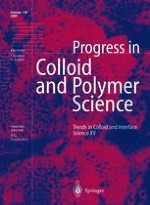2001 | OriginalPaper | Chapter
Formation and stability of nano-emulsions in mixed nonionic surfactant systems
Authors : A. Forgiarini, J. Esquena, C. González, C. Solans
Published in: Trends in Colloid and Interface Science XV
Publisher: Springer Berlin Heidelberg
Included in: Professional Book Archive
Activate our intelligent search to find suitable subject content or patents.
Select sections of text to find matching patents with Artificial Intelligence. powered by
Select sections of text to find additional relevant content using AI-assisted search. powered by
The formation of nano-emulsions has been studied in water/ mixed nonionic surfactant/oil systems using two emulsification methods. In one method, the composition was kept constant and the temperature was changed (phase-inversion temperature, PIT, method), while in the other method, water was added dropwise to a solution of the mixed surfactants in oil at constant temperature (method B). The droplet size and stability were determined as a function of surfactant mixing ratio, W1, at 25 °C. The droplet size of nano-emulsions obtained by the PIT method is practically independent of W1 and falls in the range 60-80 nm. In contrast, the droplet size of nano-emulsions prepared by method B, is highly dependent on W1 and varies between 60 and 300 nm. At W1 values where the PIT or the hydrophile—lipophile balance temperature (Thlb) of the system is close to 25 °C, the droplet sizes of the nano-emulsions are similar for both emulsification methods. There are three equilibrium phases of the latter compositions: an aqueous micellar solution or oil-in-water microemulsion (Wm), a lamellar liquid-crystalline phase and an oil phase (O) in addition, these nano-emulsions showed higher kinetic stability than those with lower W1 values (higher Thlb) and consisting of two liquid phases (Wm + O).
